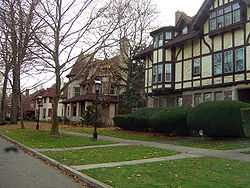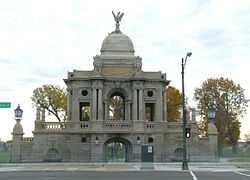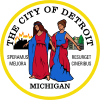Indian Village, Detroit
|
Indian Village, Detroit | |
 | |
|
Homes in Indian Village | |
| Location |
Detroit, Michigan |
|---|---|
| Coordinates | 42°21′37″N 82°59′46″W / 42.36028°N 82.99611°WCoordinates: 42°21′37″N 82°59′46″W / 42.36028°N 82.99611°W |
| Built | 1894 |
| Architectural style | Colonial Revival, Tudor Revival, Renaissance Revival, Spanish Mission Revival, Federal, Georgian Revival, other |
| Governing body | Local |
| NRHP Reference # | 72000667[1] |
| Added to NRHP | March 24, 1972 |
Indian Village is a historic, affluent neighborhood located on Detroit's east side, bound to the north and south by Mack Avenue and East Jefferson Avenue, respectively, along the streets of Burns, Iroquois, and Seminole.[2] The district was listed on the National Register of Historic Places in 1972.[1]
Description
The district has a number of architecturally-significant homes built in the early 20th century. A number of the houses have been substantially restored, and many others well kept up. Bordering Indian Village to the west is West Village, with additional historic homes, townhouses and apartments.[2]
Many of the homes were built by prominent architects, such as Albert Kahn, Louis Kamper and William Stratton, for some of the area's most prominent citizens, such as Edsel Ford. A lot of homes are very large, with some over 12,000 square feet (1,100 m²). Many have a carriage house, with some of those being larger than an average suburban home. Some of the houses also have large amounts of Pewabic Pottery tiles.[2]
Indian Village has very active community organizations, including the Indian Village Association, Men's Garden Club & Women's Garden Club. The neighborhood hosts an annual Home & Garden Tour the first Saturday of June, a neighborhood yard sales in September, a holiday home tour in December, and many other community events.[2] The neighborhood contains many historic homes including that of automotive entrepreneur Henry Leland, founder of Lincoln and Cadillac, who resided at 1052 Seminole St.[2]
Education
Detroit Public Schools operates area public schools.
Residents are zoned to Nichols Elementary School,[3][4] Marcus Garvey African Centered Academy K-8 for middle school,[5] and Southeastern High School.[6] On previous occasions Butzel Middle School served Indian Village.[7]
Private schools serving Indian Village include the Benjamin E. Mays Male Academy, the Detroit Waldorf School and Detroit Friends School.[4] Cornerstone Schools formerly operated the K-5 Iroquois Campus in Indian Village.[8][9]
Architecture
| Name[10][11] | Image | Year | Location | Style | Architect | Notes |
|---|---|---|---|---|---|---|
| John Beaumont House | 1911 | 1090 Seminole | Federal | Donaldson and Meier | Founding member of law firm of Smith, Beaumont, and Harris. | |
| Arthur and Clara Buhl House | 1908 | 1116 Iroquois | Gothic, Tudor | John Scott | Member of the family whose fortune eventually built the Buhl Building.[11] | |
| James Burgess Book Jr. House |  |
1911 | 8469 East Jefferson Ave. | Neo-Renaissance | Louis Kamper | Listed on the National Register of Historic Places.[12] |
| James Hamilton House |  |
1902 | 8325 East Jefferson Ave. | Tudor Revival | Stratton & Baldwin | Listed on the National Register of Historic Places.[12] |
| Bingley Fales House | 1907 | 1771 Seminole | Neo-Georgian | Chittenden & Kotting | At 15,000 sq ft (1,400 m2), this house is the largest in Indian Village. | |
| William F. Harris House |  |
8335 East Jefferson Ave. | Listed on the National Register of Historic Places.[12] | |||
| Christian Henry Hecker House | 1915 | 1763 Iroquois | MacFarlane, Maul, and Lentz | Son of Colonel Frank J. Hecker. Christian Hecker served as president of the Hecker Insurance Co. | ||
| George M. Holley | 1916 | 2152 Burns | William Van Tine | Founded the Holley Carburetor Company. | ||
| Hurlbut Memorial Gate |  |
1894 | E. Jefferson at Cadillac Blvd. | Beaux Arts | Brede & Mueller | Restored in 2007. Listed on the National Register of Historic Places.[12] |
| Jacob Carl Danziger House | 1911 | 1485 Burns | Bernard C. Wetzel | Danziger was treasurer and general manager of Detroit Motor Casting. | ||
| Robert Hupp House | 1911 | 1516 Iroquois Ave. | Prairie Style | George Valentine Pottle | Home of the auto baron who built the Huppmobile.[11] | |
| Louis Kamper House | 1910 | 2150 Iroquois | Neo-Renaissance | Louis Kamper | ||
| Bernard G. Koether and Harriet Bowerman House |
1923 | 2921 Burns | Herman & Simons | Koether was GM executive, director of sales, advertising, and public relations. | ||
| Jefferson Avenue Presbyterian Church | 1926 | 8625 E. Jefferson Ave. | Gothic Revival | Wirt C. Rowland | Founded in 1854. Built in 1926 by Wirt C. Rowland, the Church contains ornate carvings with corbels and shields for each of the Apostles. | |
| Julius T. Melchers House | 1897 | 723 Seyburn | Colonial Revival | Donaldson and Meier | Home of Detroit sculptor Julius T. Melchers. The gable of the house is carved by Melchers. | |
| Henry Leland House | 1901 | 1052 Seminole St. | Tudor Revival | Unknown | Henry Leland was an entrepreneur and machinist who founded Lincoln and Cadillac. | |
| Enoch Smith House aka "Ford Honeymoon House" |
1915 | 2171 Iroquois | Purchased by Edsel B. Ford in 1917. Edsel and Eleanor Ford resided in the house until 1921. Birthplace of Henry Ford II and Benson Ford. | |||
| Edwin Nelson House |  |
8311 East Jefferson Ave. | Federal | Listed on the National Register of Historic Places.[12] | ||
| Pewabic Pottery Co. | 1907 | 10125 E. Jefferson Ave. | Tudor | Stratton & Baldwin | Mary Chase Perry Stratton, the founder of Pewabic Pottery was married to one of the architects.List on the National Register of Historic Places.[12] | |
| Russel House | 1890 | 1075 Burns Ave. | Richardsonian Romanesque | Walter S. Russel | Moved to its present site in 1921, once located at Jefferson and Jos. Campau.[11] | |
| Cornelius Ray House | 1910 | 1500 Seminole | French - American colonial | Louis Kamper | [11] | |
| Mary S. Smith House |  |
8445 East Jefferson Ave. | Neo-Renaissance | List on the National Register of Historic Places.[12] | ||
| Frederick K. Stearns House |  |
1902 | 8109 East Jefferson Ave. | Tudor Revival | Stratton & Baldwin | Listed on the National Register of Historic Places.[12] |
| Detroit Waldorf School | 1913 | 2555 Burns | Albert Kahn | |||
| Henry L. Walker House | 1899 | 1005 Iroquois | Colonial Revival | Rogers and MacFarlane | ||
See also
- East Jefferson Avenue Residential TR
- Neighborhoods in Detroit
- Manoogian Mansion - The traditional residence of the city mayor of Detroit, it is located near Indian Village. The home was given to the city in 1966.
References
- ↑ 1.0 1.1 "National Register Information System". National Register of Historic Places. National Park Service. 2007-01-23.
- ↑ 2.0 2.1 2.2 2.3 2.4 Simmons, Zena (March 14, 1998). "Detroit's historic Indian Village". Michigan History, The Detroit News. Retrieved 2007-11-23.
- ↑ "Elementary School Boundary Map." Detroit Public Schools. Retrieved on October 20, 2009.
- ↑ 4.0 4.1 "Churches & Schools." Indian Village. Retrieved on March 30, 2009.
- ↑ "Middle School Boundary Map." Detroit Public Schools. Retrieved on October 20, 2009.
- ↑ "High School Boundary Map." Detroit Public Schools. Retrieved on October 20, 2009.
- ↑ "Butzel Middle School Attendance Area." Detroit Public Schools. Retrieved on March 30, 2009.
- ↑ "Contact Us." Cornerstone Schools. July 14, 2007. Retrieved on March 17, 2010.
- ↑ "Private school CEO honored for students'academic feats." The Detroit News. May 24, 1999. Retrieved on March 17, 2010. "their money and time at the Iroquois campus in Indian Village."
- ↑ Historic sites online.Michigan Historic Preservation Office. Retrieved on July 27, 2009.
- ↑ 11.0 11.1 11.2 11.3 11.4 Hill, Eric J. and John Gallagher (2002). AIA Detroit: The American Institute of Architects Guide to Detroit Architecture. Wayne State University Press. ISBN 0-8143-3120-3.
- ↑ 12.0 12.1 12.2 12.3 12.4 12.5 12.6 12.7 National Register of Historic Places - Michigan: Wayne County. National Park Service. Retrieved on July 27, 2009.
Further reading
- Hill, Eric J. and John Gallagher (2002). AIA Detroit: The American Institute of Architects Guide to Detroit Architecture. Wayne State University Press. ISBN 0-8143-3120-3.
- Meyer, Katherine Mattingly and Martin C.P. McElroy with Introduction by W. Hawkins Ferry, Hon A.I.A. (1980). Detroit Architecture A.I.A. Guide Revised Edition. Wayne State University Press. ISBN 0-8143-1651-4.
| Wikimedia Commons has media related to Indian Village Historic District (Detroit, Michigan). |
External links
| |||||||||||||
| |||||||||||||||||||||||||||||||
| |||||||||||||||||||||||||||||||||||||||||||||||||||||||||||||||||||||||||||||||||||||||||||||||||||
| ||||||||||||||||||||||||||


